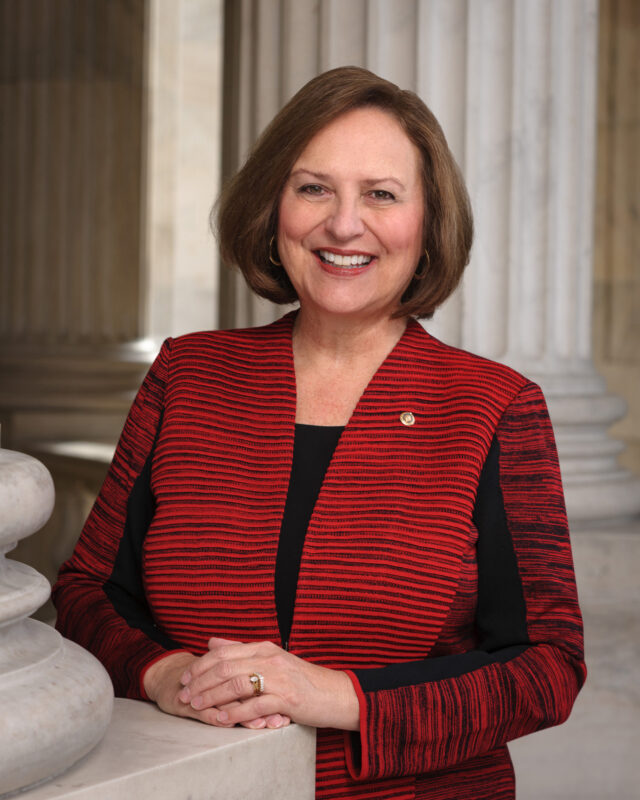![]()
“Nuclear Deterrence is the Backbone of Our National Security.”

Office of Senator Deb Fischer
This week, U.S. Senator Deb Fischer (R-Neb.), a senior member of the Senate Armed Services Committee, questioned National Nuclear Security Administration (NNSA) Administrator Jill Hruby about the agency’s efforts to modernize America’s nuclear deterrent and the importance of ending the boom-and-bust cycle of production.
At the hearing, Senator Fischer pressed Administrator Hruby about the need to build a strong foundation to address America’s long-term strategic threats, including through deeper collaboration between NNSA and U.S. Strategic Command (STRATCOM).
Senator Fischer also discussed her support for the Sea-Launched Cruise Missile (SLCM) program and NNSA’s efforts to accelerate delivery of the warhead. In the FY 24 National Defense Authorization Act, Senator Fischer secured language to create a program of record for SLCM.
Click the image above to watch a video of Sen. Fischer’s questioning
Click here to download audio
Click here to download video
On NNSA’s Critical Role in America’s Nuclear Deterrence Strategy:
Senator Fischer: Nuclear deterrence is the backbone of our national security. It underpins every operational plan that we have and every administration since the 1960s has validated the need for our nuclear triad. While the Air Force and the Navy are responsible for the bombers, ICBMs, missiles, and submarines, it is the NNSA and the Department of Energy who are responsible for the designing, manufacturing, and certifying of the nuclear weapons themselves. Transitioning back towards a production mindset has its challenges, but I understand NNSA delivered over 200 modernized nuclear weapons last year. And I’m glad to see that progress is being made and that NNSA is reprioritizing the production and delivery of nuclear weapons. Administrator, how would this budget request help NNSA to meet their requirement to increase the number of modernized nuclear weapons produced and delivered in FY25 and beyond?
Administrator Hruby: Thank you, Senator Fischer. We appreciate your recognizing that we have made significant accomplishments. This budget request for FY25 has actually more money for production modernization than it has for stockpile modernization in it; that’s not because we’re not doing stockpile modernization — we’re very focused on that — but we recognize to meet the demands over the next decade and beyond, we really have to get after our production enterprise. And in particular, a lot of the emphasis is on making sure we can bring up production at both Los Alamos and Savannah River, complete the Uranium Processing Facility and other high priorities in the system. So I think that the most important thing that NNSA can do to secure the future for the nuclear enterprise is to develop success like we are in modernizing weapons, and then modernize our infrastructure.
On Preparing For Long-Term Threats, Ending the Boom and Bust Cycle of Production:
Senator Fischer: When we visited before this hearing, we talked about balancing those seven modernization programs, and how we really can’t afford any further delays on any of those. To avoid similar boom and bust cycles in the future we have to have that groundwork laid now, the foundation laid now. Can you tell me how NNSA is working with STRATCOM to assess future threats in the late 2030s and beyond, to be able to identify the likely requirements for future nuclear weapons programs?
Administrator Hruby: Yes, Senator, thank you. This is one of the things I’m very proud to say that we’ve made a significant progress working with General Cotton. We have agreed that we really need to define those needs beyond the mid 2030s, which is where the program of record today ends; we’ve got seven things going on between now and the mid-2030s, but we know we have needs beyond that. And we’ve reestablished a process that used to exist — it had gone quiet — to have STRATCOM staff, who understand and think about deterrence needs on a daily basis, to work with our staff, who think about and understand capabilities on a daily basis. To work together more closely on and to meet regularly to define, what is the gap? And what’s the best way to fill it that will exist in the late 2030s and 2040s.
On the Need for the Fischer-Backed Sea-Launched Cruise Missile Program:
Senator Fischer: You know, I’ve really appreciated our discussions on how we can accelerate the delivery of SLCM. And I’ve appreciated that you have that request in the unfunded priority list for $70 million for SLCM. I think that does demonstrate a really clear commitment to meeting the requirements that are now set in law. Administrator, can you provide us with an update on how the NNSA is moving forward with the development of the warhead.
Administrator Hruby: Yes, we are looking, working very closely with the Navy as they define their delivery platform, to define the warhead that will match well to that. Our objective because we’re trying to do this and in the program of record, we’re trying to squeeze it between some programs that we are already working on, is to find the most effective and simplest way that won’t disrupt the rest of the program of record to meet the requirements for SLCM-N. So we’re looking at the W80-4, as was in the authorizing language; we’re also looking at other options that might — we don’t know yet — be simpler to do in terms of disrupting our current production flow.
